

Tamil Nadu, located in southern India, is one of the country's most culturally rich states. It is famous for its magnificent Dravidian-style temples, classical dance form Bharatanatyam, and Carnatic music. The state has a glorious history dating back to ancient times, shaped by the Chola, Chera, and Pandya dynasties. From the temple cities of Madurai and Thanjavur to the hill stations of Ooty and Kodaikanal, Tamil Nadu offers a perfect blend of spirituality, history, and natural beauty. Its festivals, especially Pongal, bring people together in celebration and devotion.
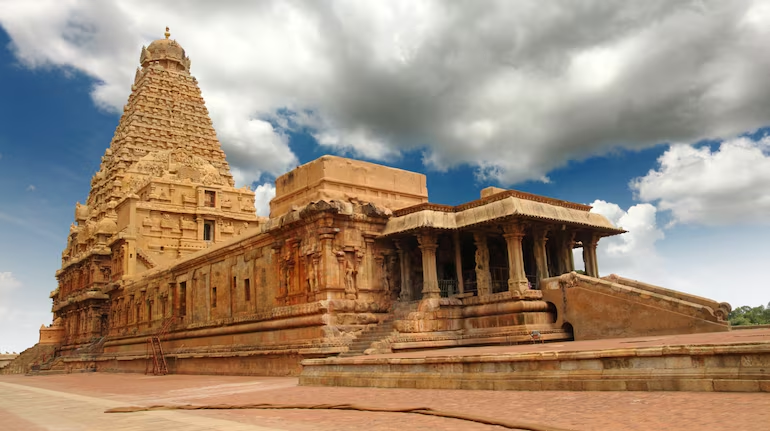
Tamil Nadu stands as a testament to one of the world's oldest living civilizations, with a recorded history spanning over two millennia. The state was home to three great ancient Tamil kingdoms - the Cholas, Cheras, and Pandyas - whose legacy continues to shape Tamil identity and pride.
The Chola Empire, at its peak between the 9th and 13th centuries, was one of the longest-ruling dynasties in world history. Under rulers like Rajaraja Chola I and his son Rajendra Chola I, the empire expanded across South India, Sri Lanka, Maldives, and parts of Southeast Asia, establishing Tamil influence across the Indian Ocean region.
The Cholas were not only brilliant warriors but also master administrators and builders. They established an efficient system of local governance, advanced irrigation techniques, and built magnificent temples that stand as architectural marvels even today. The Brihadeeswarar Temple in Thanjavur, built by Rajaraja Chola I, is a UNESCO World Heritage Site and represents the pinnacle of Chola architecture.
The Pandya dynasty, centered in Madurai, was known for its patronage of Tamil literature and the arts. The Meenakshi Temple in Madurai, with its stunning gopurams (towering gateways), remains one of India's most visited pilgrimage sites. The Cheras, ruling from the western part of Tamil Nadu, were renowned for their maritime trade and cultural contributions.
These dynasties made significant contributions to literature, art, architecture, and governance. The Sangam literature, composed between 300 BCE and 300 CE, represents some of the finest works in Tamil and provides insights into the social, cultural, and economic life of ancient Tamils.
Today, Tamil Nadu takes immense pride in this glorious heritage. The temples built by these dynasties are not just places of worship but living monuments that continue to be centers of cultural and social life. The values of justice, good governance, and cultural excellence established by these ancient rulers are deeply embedded in Tamil society.
The legacy of the Tamil kingdoms is not just historical; it continues to inspire contemporary Tamil identity. The Tamil language, with its 2000-year literary history, remains a powerful symbol of cultural pride and resilience. The administrative systems, irrigation techniques, and architectural principles developed during these periods continue to influence modern practices.
Tamil Nadu is known for its strong linguistic identity and rich literary heritage. The state's language landscape reflects its ancient traditions, classical literature, and cultural pride.
The official language of Tamil Nadu is Tamil, one of the world's oldest living languages with a history spanning over 2000 years. Tamil belongs to the Dravidian language family and is recognized as a classical language by the Government of India. It is not only used in government, education, and administration but also in literature, cinema, and music, making it the heart of Tamil cultural identity.
The languages of Tamil Nadu reflect its unique cultural identity and historical continuity. While Tamil remains the heart and soul of the state, the presence of English and other regional languages adds to its linguistic diversity. This blend of languages truly mirrors Tamil Nadu's spirit of cultural pride while embracing modernity.
Tamil Nadu is a state of vibrant festivals, where tradition, devotion, and cultural celebrations come alive. Festivals here are deeply rooted in agricultural cycles, temple traditions, and classical arts, reflecting the state's rich heritage.
Pongal is the most important and widely celebrated festival of Tamil Nadu, marking the harvest season and the beginning of the Tamil month Thai. It is a four-day festival that expresses gratitude to nature, farm animals, and the Sun God for a bountiful harvest.
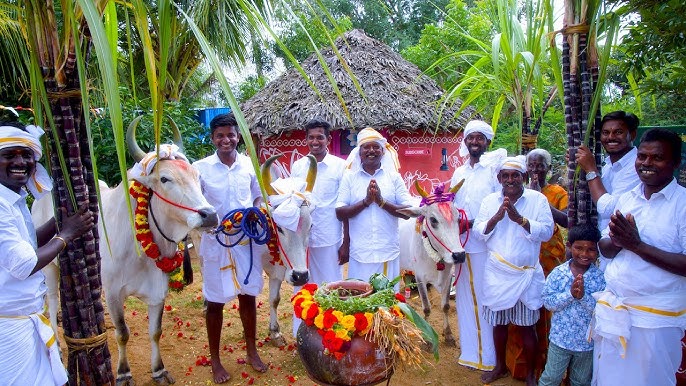
Pongal is not just a festival but a celebration of Tamil Nadu's agricultural heritage, cultural identity, and spiritual values. It brings families and communities together, spreading the message of gratitude, prosperity, and harmony with nature. The chanting of "Pongalo Pongal" during the boiling over of milk rice symbolizes abundance and joy, making this festival the true essence of Tamil pride.
Puthandu, the Tamil New Year, is celebrated on the first day of the Tamil month Chithirai (usually April 14). It marks the beginning of the Tamil calendar and is observed with religious ceremonies, cultural events, and family gatherings. The festival symbolizes new beginnings, prosperity, and the victory of good over evil. On this day, people wake up early, take oil baths, wear new clothes, and decorate their homes with kolam (rangoli) designs. A special viewing called "Kanni" is arranged, where families view auspicious items like fruits, vegetables, jewelry, and money, symbolizing prosperity for the coming year. Temples witness special prayers and rituals, and people visit relatives to exchange greetings and gifts. The festival is also associated with mythological significance. According to Hindu beliefs, it was on this day that Lord Brahma started creation. The day also marks the beginning of Chithirai Thiruvizha, the great temple festival at Meenakshi Temple in Madurai.
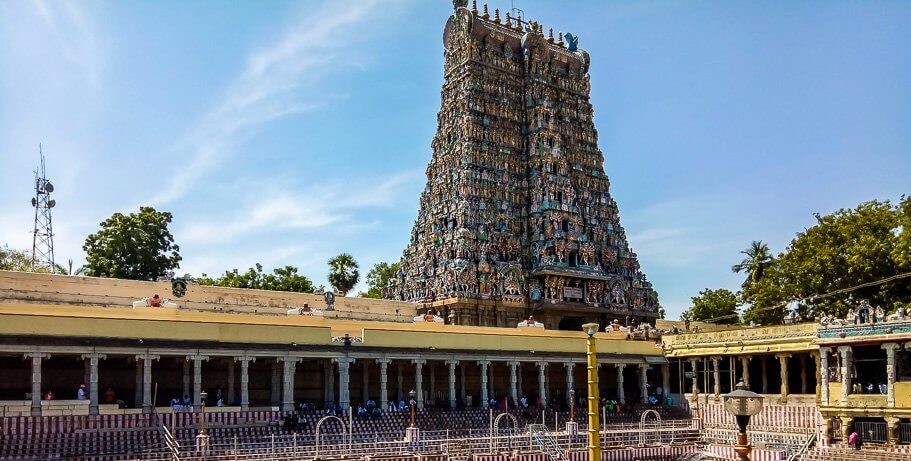
In conclusion, Puthandu is not just the celebration of a new year but a festival of hope, renewal, and cultural pride. It brings families together, strengthens community bonds, and inspires people to begin the year with positivity, devotion, and traditional values.
Puthandu is not just the celebration of a new year but also a festival of cultural reaffirmation and family bonding. It reflects the cultural richness of Tamil Nadu, reminding people to welcome life with positivity, tradition, and unity. With its blend of rituals, food, and traditions, Puthandu truly symbolizes the spirit of renewal and pride of Tamil Nadu.
Deepavali, known as the Festival of Lights, is celebrated with great enthusiasm in Tamil Nadu. While it shares similarities with North Indian Diwali celebrations, Tamil traditions add unique cultural elements to the festival.
Deepavali in Tamil Nadu is not just a festival of lights but a celebration of cultural identity, family values, and spiritual enlightenment. From the traditional oil bath to the worship of Lakshmi, every tradition reflects the unique Tamil way of celebrating this pan-Indian festival.
The festivals of Tamil Nadu showcase its deep spiritual roots, agricultural heritage, and cultural richness. From the harvest celebrations of Pongal to the temple festivals of Madurai, every festival reflects the state's spirit of devotion, community, and pride in its heritage.

Tamil Nadu is one of India's most urbanized states with cities that blend ancient heritage with modern development. Its urban centers are not only economic hubs but also custodians of Tamil culture, art, and traditions. Each city plays a unique role in shaping Tamil Nadu's identity and pride.
Chennai, the capital city of Tamil Nadu, is popularly known as the "Gateway to South India" because of its strategic location and cultural significance. It is India's fourth-largest metropolitan city and serves as the economic, cultural, and educational hub of Tamil Nadu. Chennai beautifully balances tradition with modernity, making it one of India's most dynamic cities.
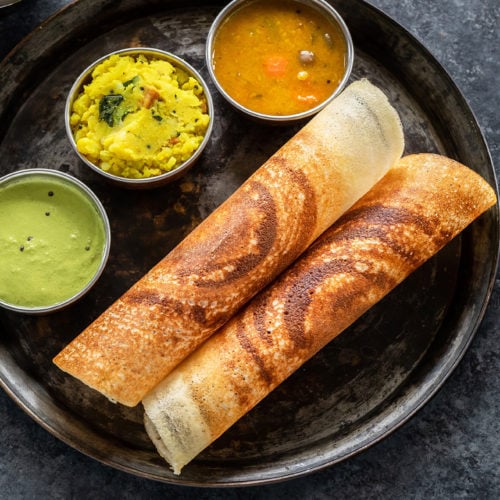


Marina Beach in Chennai is one of the most famous landmarks in India and the second-longest urban beach in the world, stretching for 13 kilometers along the Bay of Bengal. It is not just a natural wonder but also a cultural and recreational hub that reflects the spirit of Chennai.
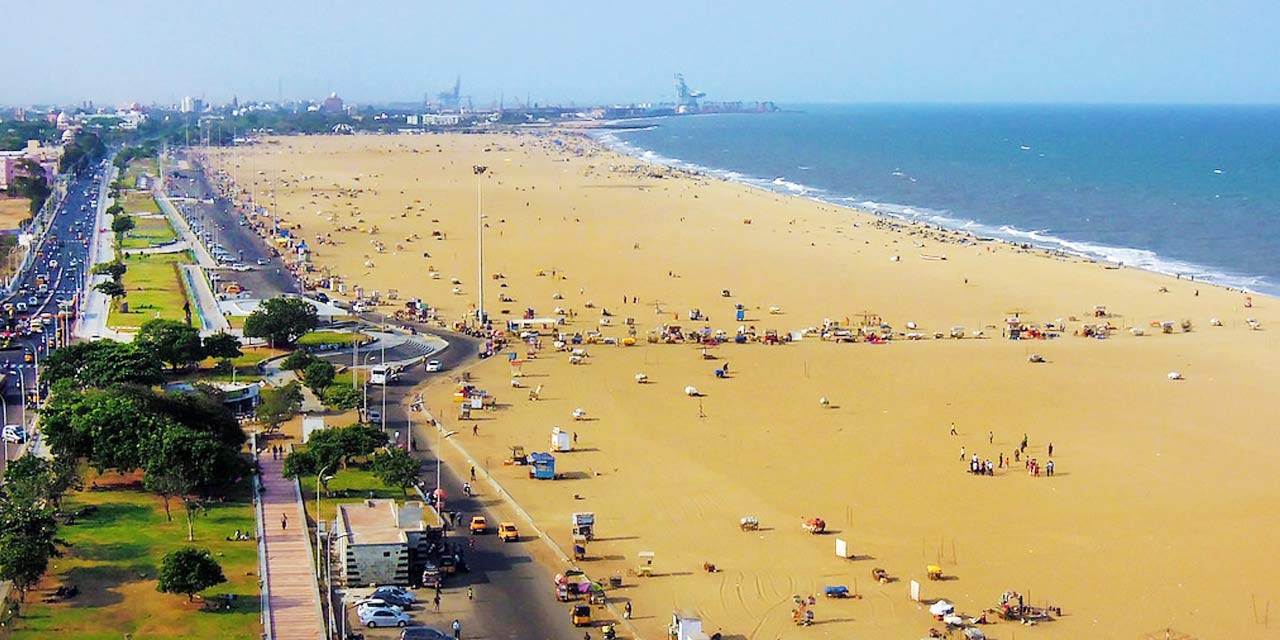
The beach is famous for its wide sandy shore, gentle waves, and stunning sunrises and sunsets. It is lined with several important monuments and statues, including the statues of Tamil icons like Thiruvalluvar, Kannagi, and political leaders. The beach also features the Anna Memorial and the MGR Memorial, which are major tourist attractions.
Marina Beach is more than just a tourist spot; it is an integral part of Chennai's identity. Locals flock to the beach every evening for walks, family outings, and to enjoy the sea breeze. The beach comes alive with food stalls selling local snacks like sundal (spiced chickpeas), murukku, and other Tamil delicacies.
Despite the 2004 tsunami that caused significant damage, Marina Beach has been restored and continues to be Chennai's pride. It represents the city's resilience and its deep connection with the sea.
In conclusion, Marina Beach is much more than a natural attraction—it is a symbol of Chennai's cultural life, historical pride, and the simple joys of its people. It stands as a reminder of the city's coastal heritage and continues to welcome millions of visitors who come to experience its beauty and vibrancy.
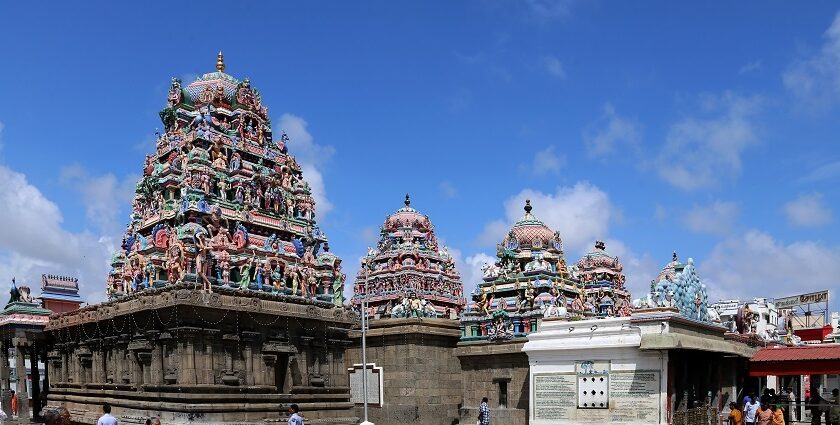
The Kapaleeshwarar Temple in Mylapore, Chennai, is one of the most ancient and significant Shiva temples in Tamil Nadu. Dedicated to Lord Shiva, this temple is a masterpiece of Dravidian architecture and a living center of Tamil culture and spirituality.
Built in the 7th century CE by the Pallava kings, the temple features a magnificent 37-meter gopuram (tower) adorned with intricate sculptures depicting various Hindu deities and mythological scenes. The temple tank, known as the Mylapore Tank, adds to the spiritual ambiance of the complex.
The temple is particularly famous for its association with the Tamil saint poets (Nayanmars), especially Saint Sambandar, who composed devotional hymns about the deity. The temple celebrates various festivals throughout the year, with the Arupathimoovar Festival during the Tamil month of Panguni (March-April) being the most important.
What makes Kapaleeshwarar Temple unique is its vibrant cultural life. The temple is not just a place of worship but also a center for music, dance, and Tamil literary activities. The annual music festival during Margazhi attracts renowned artists and music lovers from across the country.
In conclusion, the Kapaleeshwarar Temple is much more than a religious site—it is a living monument of Tamil heritage, architectural brilliance, and spiritual devotion. It continues to inspire awe and devotion, representing both the legacy of ancient Tamil civilization and the vibrant cultural life of contemporary Chennai.
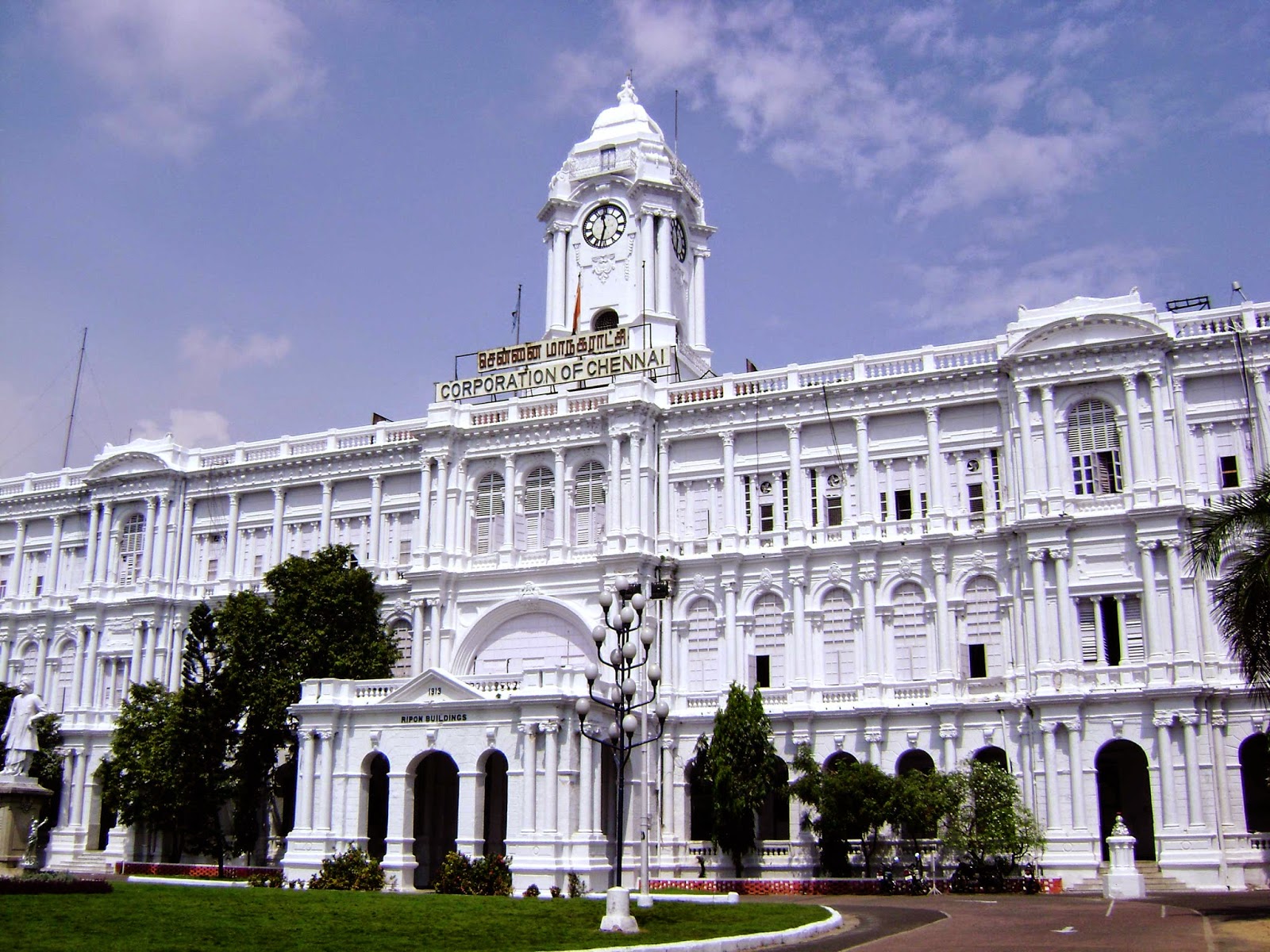
Fort St. George in Chennai is one of the most important historical landmarks in India, representing the beginning of British colonial rule in the subcontinent. Built in 1639 by the British East India Company, it is the first English fortress in India and now serves as the administrative headquarters of the Tamil Nadu government.
The fort complex houses several historically significant buildings, including St. Mary's Church, the oldest Anglican church in India, and the Fort Museum, which displays artifacts from the British colonial period. The fort's ramparts, cannons, and colonial-era buildings transport visitors back to the 17th century, offering a glimpse into India's colonial history.
Today, Fort St. George serves as the seat of the Tamil Nadu Legislative Assembly and Secretariat, making it the center of political power in the state. Despite its administrative functions, the fort remains open to visitors who wish to explore its historical significance and architectural beauty.
The fort represents an important chapter in Chennai's history, marking the transformation of a small fishing village into a major metropolitan city. It stands as a testament to the city's growth and its complex relationship with colonial history.
In conclusion, Fort St. George is much more than a historical monument—it is a living symbol of Chennai's transformation from a colonial outpost to a modern metropolis. As the center of Tamil Nadu's administration, it continues to play a vital role in the state's political life while preserving its historical legacy.
Valluvar Kottam in Chennai is a magnificent monument dedicated to the great Tamil poet and philosopher Thiruvalluvar, author of the Thirukkural. This architectural marvel is not just a memorial but a celebration of Tamil language, literature, and philosophical thought.
The centerpiece of Valluvar Kottam is a 33-meter tall chariot-shaped structure that represents the 133 chapters of the Thirukkural. The monument is built entirely of granite without using any structural steel, showcasing the engineering skills of Tamil architects. Inside the chariot is a life-size statue of Thiruvalluvar, and the walls are inscribed with all 1330 couplets of the Thirukkural.
The monument was built in 1976 by then Chief Minister M. Karunanidhi to honor Thiruvalluvar's contributions to Tamil literature and philosophy. The Thirukkural, written over 2000 years ago, remains relevant today for its timeless wisdom on ethics, governance, and love.
Valluvar Kottam also features an auditorium with a seating capacity of 4000 people, making it one of the largest in Asia. The monument complex includes a beautiful garden and a pond that adds to its serene atmosphere.
Today, Valluvar Kottam is not just a tourist attraction but a center for cultural and literary activities. It hosts various events related to Tamil literature, music, and dance, keeping the Tamil cultural tradition alive.
In conclusion, Valluvar Kottam is more than a memorial—it is a symbol of Tamil pride, literary excellence, and philosophical wisdom. It stands as a tribute to one of the greatest minds in Tamil history and continues to inspire generations with the timeless values of the Thirukkural.
The Government Museum in Chennai, established in 1851, is the second oldest museum in India after the Indian Museum in Kolkata. It houses one of the richest collections of archaeological and historical artifacts in South India, making it a treasure trove for history enthusiasts and researchers.
The museum complex spans across six buildings and 16 galleries, featuring collections that span from the prehistoric period to modern times. The Bronze Gallery is particularly famous for its exquisite collection of Chola bronzes, considered among the finest in the world. The Amaravati Gallery houses Buddhist sculptures and relics from the ancient Amaravati stupa.
Other notable sections include the Anthropology Gallery, which displays artifacts from Tamil Nadu's tribal communities, and the Numismatics Section, which has one of the largest collections of coins in India. The museum also has a rich collection of paintings, manuscripts, and arms and armor.
The Government Museum plays a crucial role in preserving and promoting Tamil Nadu's cultural heritage. It serves as an important educational resource for students, researchers, and anyone interested in South Indian history and culture.
In conclusion, the Government Museum in Chennai is not just a repository of artifacts but a living institution that preserves Tamil Nadu's rich historical legacy. It stands as a testament to the state's ancient civilization, artistic achievements, and cultural continuity through the ages.
Chennai is more than just a city — it is the cultural heart of Tamil Nadu and the gateway to South India. From its ancient temples to its modern IT corridors, from classical music to contemporary cinema, Chennai represents the perfect blend of tradition and modernity. Truly, Chennai lives up to its name as the Gateway to South India.
Madurai, one of the oldest continuously inhabited cities in the world, is fondly called the "Temple City" because of its magnificent Meenakshi Amman Temple. It is a city where history, spirituality, and Tamil culture converge — known for its ancient temples, vibrant markets, and literary heritage.
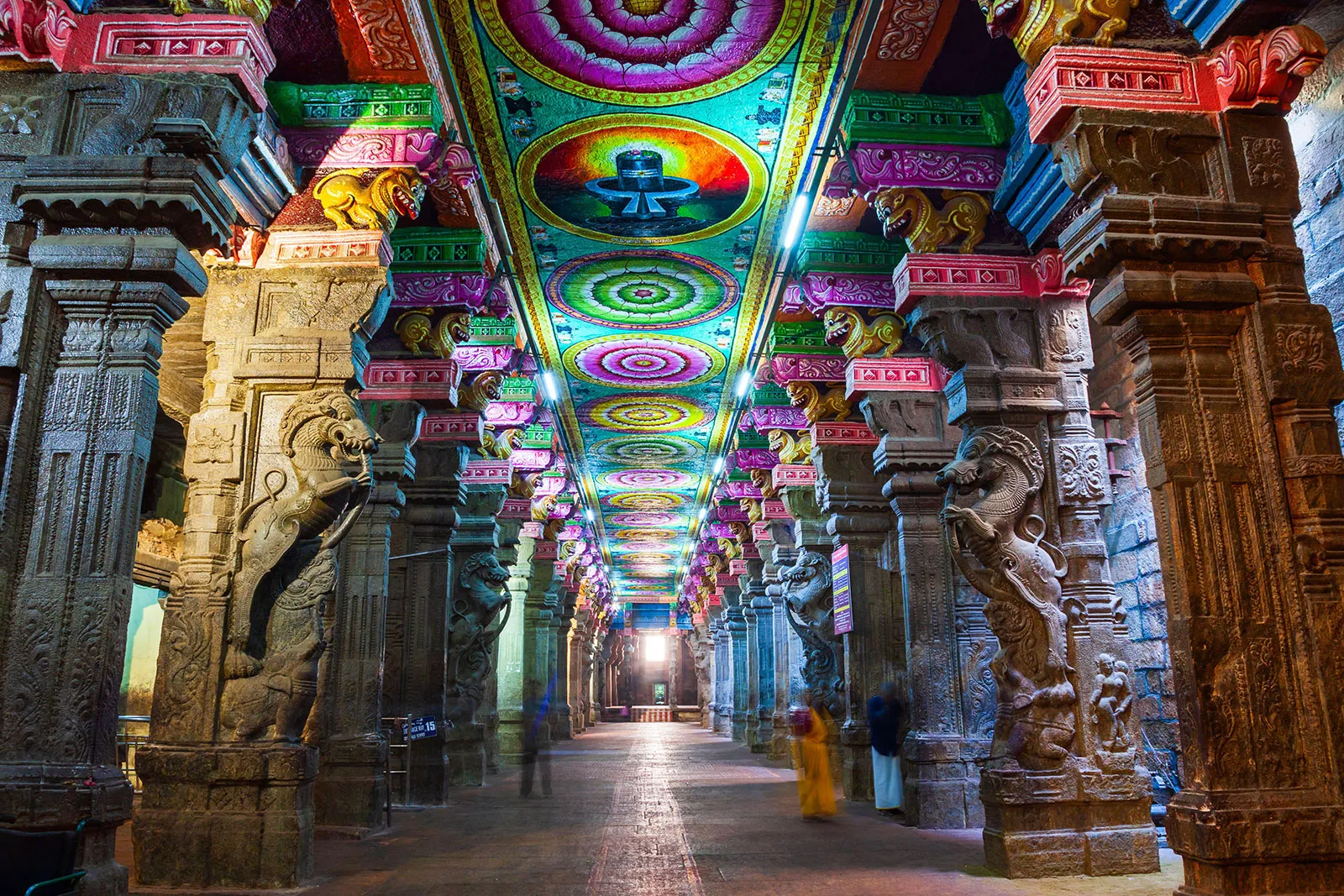
The Meenakshi Amman Temple in Madurai is one of the most magnificent and ancient temples in India, dedicated to Goddess Meenakshi (an incarnation of Parvati) and her consort Sundareswarar (Shiva). This architectural marvel is not just a place of worship but the very heart and soul of Madurai, representing the pinnacle of Dravidian temple architecture.
The temple complex spans 14 acres and features 14 magnificent gopurams (towering gateways), with the southern gopuram being the tallest at 52 meters. These gopurams are covered with thousands of colorful stucco figures depicting gods, goddesses, and mythological scenes. The temple's most famous feature is the Hall of Thousand Pillars (Aayiram Kaal Mandapam), which actually contains 985 beautifully carved pillars.
The temple has a rich history dating back to the Pandya period (6th century CE) but reached its current form during the Nayak rule in the 16th-17th centuries. The temple is not just an architectural wonder but also a living center of Tamil culture, hosting daily rituals, festivals, and cultural events throughout the year.
The most important festival is the Chithirai Thiruvizha, a month-long celebration that culminates in the celestial marriage of Meenakshi and Sundareswarar, attracting over a million devotees. The temple also plays a crucial role in the social and economic life of Madurai, with its surrounding streets forming a vibrant market known as the "Temple Bazaar."
In conclusion, the Meenakshi Amman Temple is much more than a religious site—it is a symbol of Tamil cultural identity, architectural brilliance, and spiritual devotion. It continues to inspire awe and devotion, standing as a testament to Madurai's glorious past and vibrant present.
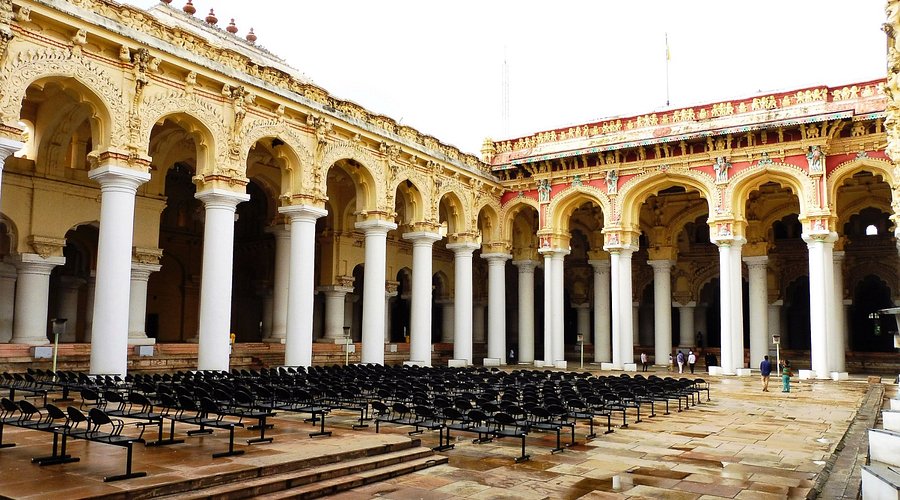
The Tirumalai Nayakkar Palace in Madurai is a magnificent 17th-century palace built by King Tirumalai Nayak, one of the most prominent rulers of the Madurai Nayak dynasty. This architectural masterpiece represents the fusion of Dravidian and Islamic styles, creating a unique Indo-Saracenic architectural form.
The palace was originally four times larger than its current structure, with two main parts: Swarga Vilasam (the royal residence) and Ranga Vilasam (the entertainment area). Though much of the palace was destroyed over time, the restored Swarga Vilasam gives visitors a glimpse of its former grandeur. The palace features massive pillars, ornate stucco work, and a dome that rises to a height of 20 meters without any support.
The most striking feature of the palace is the courtyard, which measures 3,900 square meters and is surrounded by massive circular pillars. The palace also has a museum that displays artifacts from the Nayak period, including sculptures, paintings, and other historical objects.
Today, the palace is not just a tourist attraction but also a venue for cultural events, including sound and light shows that narrate the history of Madurai and the Nayak dynasty. The palace stands as a testament to the architectural brilliance and royal splendor of the Nayak period.
In conclusion, the Tirumalai Nayakkar Palace is more than a historical monument—it is a symbol of Madurai's royal heritage and architectural innovation. It continues to captivate visitors with its grandeur and serves as a reminder of Madurai's importance as a cultural and political center in South India.
The Gandhi Memorial Museum in Madurai is one of the five Gandhi museums in India, established in 1959. Housed in the historic Tamukkam Palace, the museum preserves and displays artifacts related to Mahatma Gandhi's life and India's freedom struggle, making it an important center for historical education and inspiration.
The museum features several galleries that chronicle Gandhi's life from his childhood to his assassination. The most poignant exhibit is the blood-stained dhoti that Gandhi was wearing when he was assassinated. Other important displays include personal letters, photographs, and documents related to the freedom movement.
The museum also houses a library with over 15,000 books on Gandhi, the freedom movement, and related topics. It serves as a research center for scholars and students interested in Gandhian philosophy and India's struggle for independence.
What makes this museum unique is its location in Madurai, a city that Gandhi visited several times and where he adopted the loincloth for the first time, marking a significant turning point in his life. The museum thus has special significance in the narrative of Gandhi's transformation and his connection with Tamil Nadu.
In conclusion, the Gandhi Memorial Museum in Madurai is not just a repository of historical artifacts but a living institution that promotes Gandhian values and educates future generations about India's freedom struggle. It stands as a tribute to the Mahatma's legacy and his deep connection with the people of Tamil Nadu.
Alagar Koyil, located about 21 kilometers from Madurai, is a famous hill temple dedicated to Lord Vishnu in his form as Alagar (the beautiful one). This ancient temple is an important pilgrimage site and plays a significant role in the Chithirai Festival of Madurai.
The temple is situated on a hill amidst natural surroundings, offering panoramic views of the countryside. The main deity, Alagar, is depicted in a standing posture and is considered one of the 108 Divya Desams (holy abodes of Vishnu). The temple architecture follows the classic Dravidian style with intricate carvings and sculptures.
Alagar Koyil is particularly famous for its role in the Chithirai Festival. According to legend, Alagar is the brother of Goddess Meenakshi, and during the festival, he travels from his hill temple to Madurai to attend his sister's wedding. This journey is reenacted annually with great pomp and ceremony, attracting thousands of devotees.
The temple complex includes several mandapams (halls), water tanks, and shrines. The natural beauty of the surrounding hills and the spiritual atmosphere make it a popular destination for both pilgrims and nature lovers.
In conclusion, Alagar Koyil is more than just a temple—it is an integral part of Madurai's religious and cultural landscape. Its connection with the Meenakshi Temple through the Chithirai Festival highlights the harmonious coexistence of Shaivism and Vaishnavism in Tamil tradition, making it a unique symbol of Tamil religious harmony.
The Koodal Azhagar Temple in the heart of Madurai is an ancient temple dedicated to Lord Vishnu in his form as Koodal Azhagar. This temple is one of the 108 Divya Desams and holds significant religious and historical importance in Tamil Vaishnavism.
The temple's history dates back to the Sangam period (3rd century BCE to 3rd century CE), with references found in Tamil literature. The current structure was built during the Pandya and Nayak periods, featuring classic Dravidian architecture with beautiful sculptures and intricate carvings.
The main deity, Koodal Azhagar, is depicted in three postures: sitting, standing, and reclining, representing the three states of consciousness. The temple is particularly famous for its magnificent mandapams (halls) and the stunning gold-plated vimana (tower over the sanctum).
Koodal Azhagar Temple is not just a place of worship but also a center of Tamil literary tradition. The temple has been praised in the works of the Alvar saints, the Tamil poet-saints of the 6th-9th centuries who composed devotional hymns in praise of Vishnu.
In conclusion, the Koodal Azhagar Temple is a significant religious and cultural landmark in Madurai, representing the rich tradition of Tamil Vaishnavism. Its ancient heritage, architectural beauty, and spiritual significance make it an essential part of Madurai's identity as the Temple City.
Madurai is not just a city of temples but also of living traditions, vibrant culture, and historical continuity. With its ancient heritage, spiritual significance, and cultural vibrancy, Madurai rightfully earns the title of the "Temple City", making it one of the most significant cultural centers of Tamil Nadu and India.
Coimbatore, the second-largest city in Tamil Nadu, is popularly known as the "Manchester of South India" due to its extensive textile industry. Strategically located in the western part of the state, it serves as a major industrial, commercial, and educational hub. Beyond its industries, Coimbatore is also the gateway to the hill stations of the Western Ghats.
Coimbatore is much more than just the Manchester of South India — it is a city of enterprise, education, and cultural harmony. With its strategic location, booming industries, and quality of life, Coimbatore stands as a symbol of Tamil Nadu's industrial prowess while maintaining its cultural roots.
Trichy, officially known as Tiruchirappalli, is one of the oldest cities in Tamil Nadu and is famous for its Rock Fort Temple that dominates the city's skyline. Located on the banks of the Kaveri River, Trichy beautifully blends historical significance, religious importance, and modern development, making it one of Tamil Nadu's most important cities.
Trichy is not just a historical city but also a symbol of Tamil Nadu's religious diversity and architectural heritage. With its ancient temples, strategic rock fort, and modern development, Trichy truly reflects a fusion of tradition and progress. Its title as the Rock Fort City highlights both its historical significance and its unique geographical identity.
Thanjavur, located in the Cauvery delta region, is popularly known as the "Rice Bowl of Tamil Nadu" because of its fertile agricultural lands. The city was the capital of the great Chola Empire and is home to the UNESCO World Heritage Site Brihadeeswarar Temple, making it one of Tamil Nadu's most important historical and cultural destinations.
Thanjavur stands as a living museum of history, art, and agriculture. From the magnificent Brihadeeswarar Temple to the fertile paddy fields that gave it its name, the city reflects the grandeur of the Chola period and the agricultural prosperity of the Cauvery delta. Its rich cultural mix, historical treasures, and agricultural significance make Thanjavur rightfully known as the Rice Bowl of Tamil Nadu and one of the state's proudest heritage centers.
The cities of Tamil Nadu reflect the soul of the state. While Chennai showcases modernity and industry, Madurai treasures spirituality, Coimbatore represents enterprise, Trichy preserves historical heritage, and Thanjavur maintains agricultural traditions. Together, these cities present a perfect balance of heritage, culture, progress, and modernity, making Tamil Nadu one of the most culturally rich states in India.
The fashion of Tamil Nadu is deeply rooted in its ancient cultural heritage, temple traditions, and regional identity. Clothing in the state reflects simplicity, elegance, and a strong sense of Tamil cultural pride. From traditional temple silk to contemporary adaptations, Tamil Nadu's fashion scene offers a perfect blend of history and modern style.
Tamil Nadu's traditional men's attire reflects the state's cultural pride, simplicity, and connection to its ancient heritage. It varies from the simple daily wear of farmers to the elegant silk garments worn for ceremonies and temple visits. Even today, during festivals, weddings, and cultural events, men proudly wear these traditional outfits to honor their Tamil roots.

Traditional men's fashion in Tamil Nadu is a blend of simplicity, dignity, and cultural heritage. From the everyday white veshti to the elegant silk attire for special occasions, each element narrates the story of Tamil culture, history, and pride.
The traditional attire of Tamil women is a reflection of elegance, cultural richness, and ancient heritage. From the classic nine-yard saree to the daily wear six-yard saree, Tamil women's fashion highlights both grace and cultural identity. These outfits are worn proudly during weddings, festivals, temple visits, and cultural ceremonies.

Traditional women's fashion in Tamil Nadu is a beautiful blend of elegance, cultural richness, and identity. From the luxurious Kanchipuram silk sarees to the practical daily wear cotton sarees, and from traditional temple jewelry to fragrant flower adornments, Tamil women's attire continues to reflect the rich heritage and timeless pride of Tamil culture.
Tamil Nadu is renowned for its rich textile heritage, with each region specializing in unique fabrics and weaving techniques. The state's textiles reflect centuries-old craftsmanship, cultural symbolism, and artistic excellence, making them an integral part of Tamil identity and pride.
Tamil Nadu's fabrics and textiles are a treasure of heritage and craftsmanship. From the luxurious Kanchipuram silk with intricate zari work to the practical cotton handlooms and traditional weaving techniques, these textiles not only adorn the people but also tell the story of Tamil culture, artistry, and pride.
While Tamil Nadu is deeply rooted in traditional attire, modern fashion has made a significant impact, especially in urban areas like Chennai and Coimbatore. Today, people blend Western clothing, contemporary Indian styles, and traditional elements to create a unique fashion identity. Tamil Nadu's fashion scene reflects its cosmopolitan culture, youthfulness, and creativity while maintaining strong cultural roots.
Modern fashion in Tamil Nadu is a perfect blend of tradition and contemporary style. While urban youth embrace global trends, festivals and special occasions still honor Tamil heritage through traditional wear. This combination of old and new makes Tamil Nadu a vibrant hub of style, creativity, and cultural pride, where fashion becomes a medium of cultural expression and identity.
Tamil Nadu's fashion is a beautiful blend of ancient tradition and modern innovation. From the regal Kanchipuram silk sarees and traditional veshti to contemporary fusion wear in urban centers, the state's clothing heritage continues to inspire India's fashion industry. It not only reflects the cultural pride of Tamil Nadu but also evolves with changing times, maintaining its unique identity while embracing global influences.